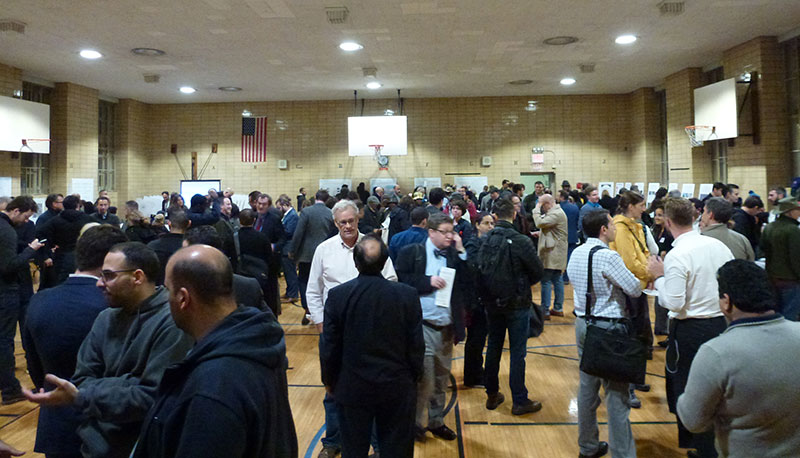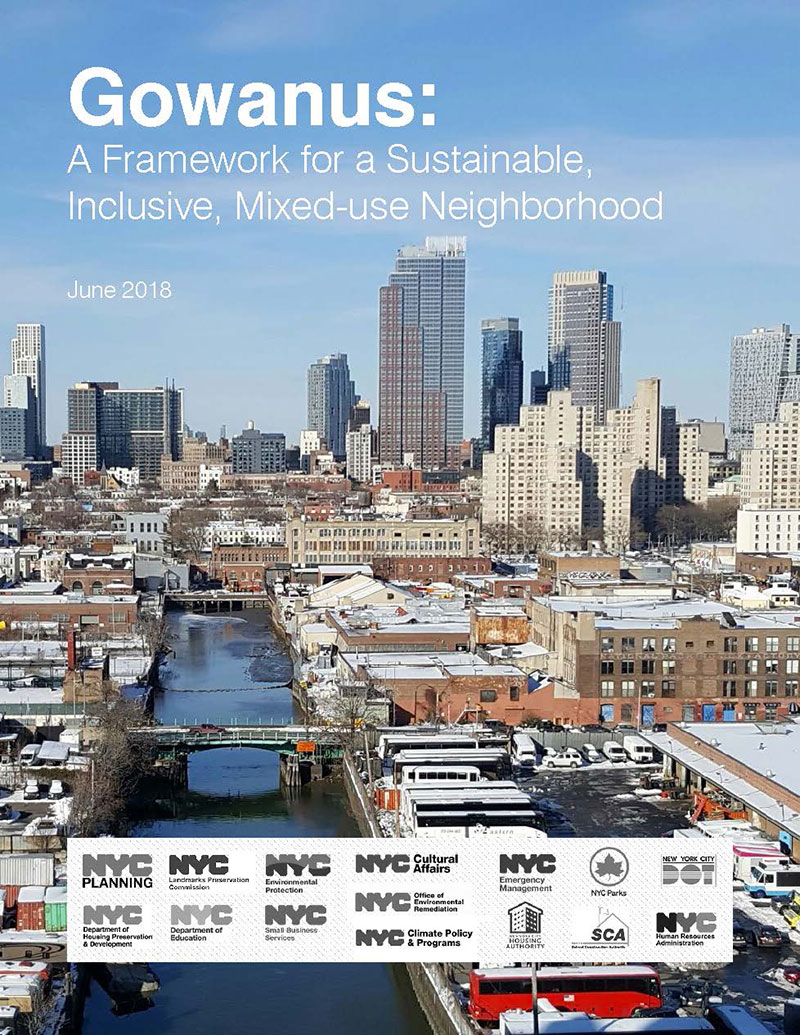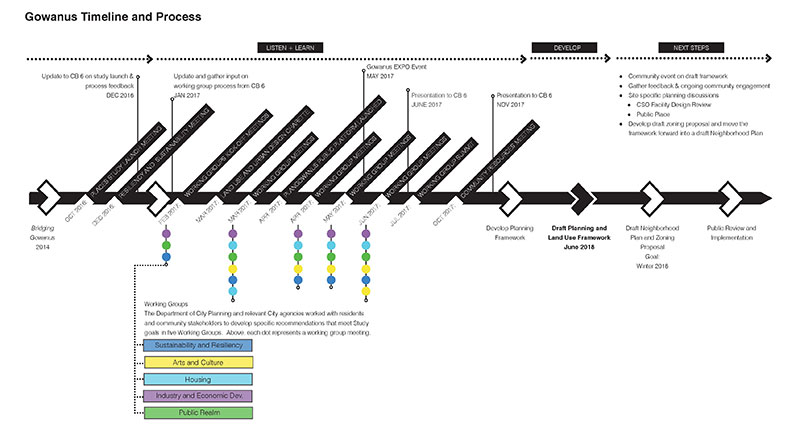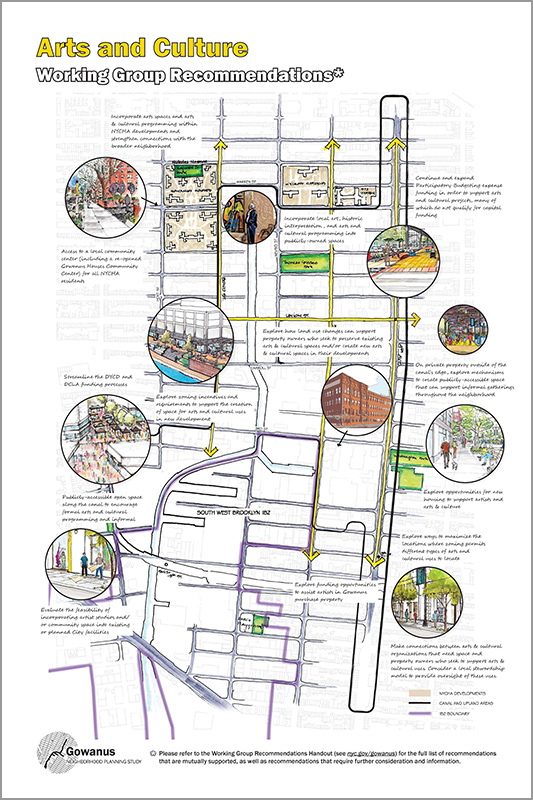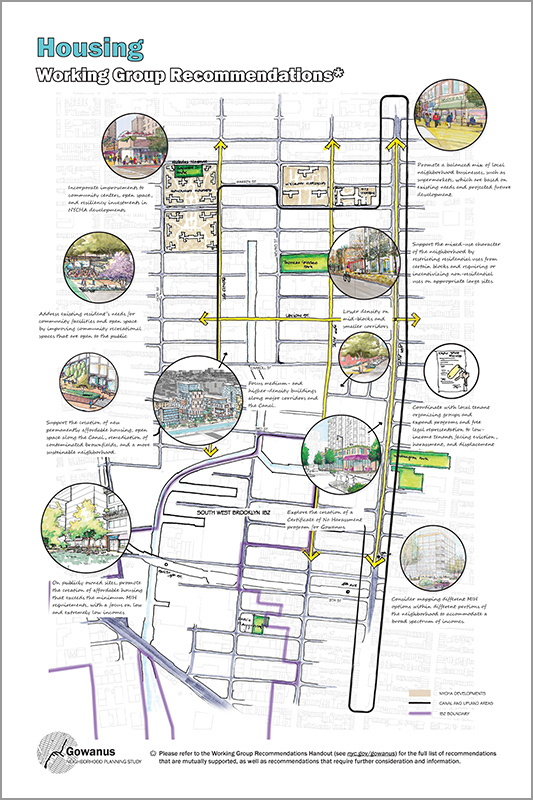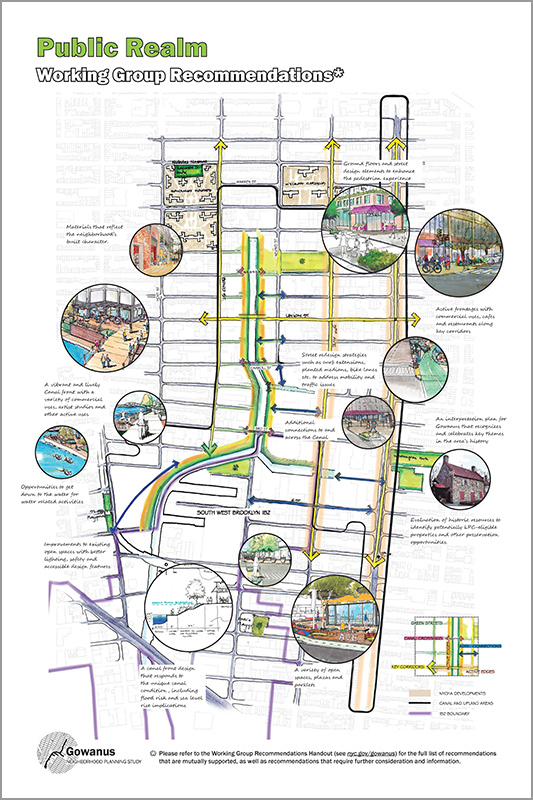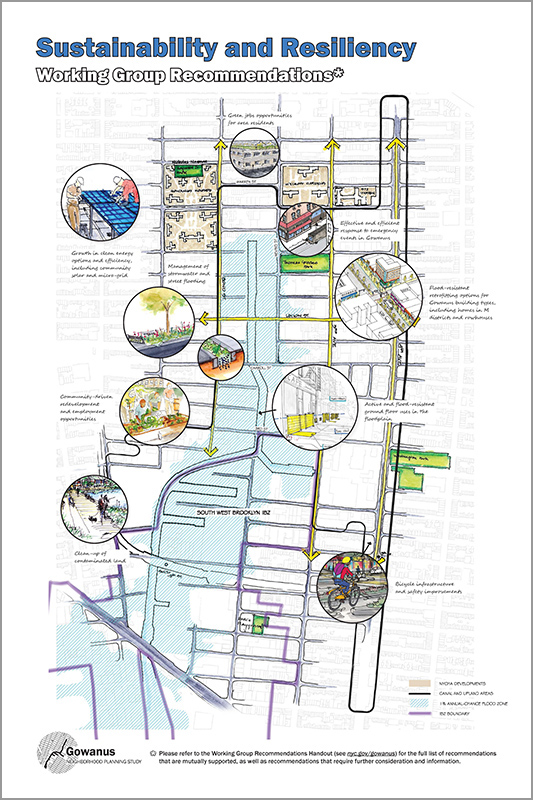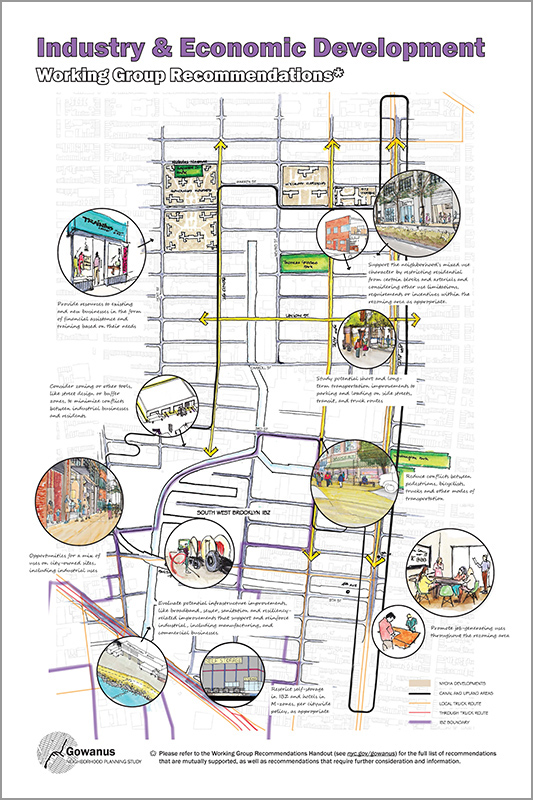
 Department of City Planning311
Department of City Planning311 Search all NYC.gov websites
Search all NYC.gov websites
Gowanus Neighborhood Planning Study

Since the release of the draft zoning proposal in January, DCP and the inter-agency team have held and attended numerous public events and met with Community Board 6, community groups, elected officials and stakeholders to discuss, share information, answer questions, and receive input on a variety of topics including the draft zoning, affordability, Mandatory Inclusionary Housing (MIH), the Waterfront Access Plan (WAP), and emergency preparedness planning.
Community Board 6
DCP and the Department of Housing Preservation and Development (HPD) discussed the proposed WAP and affordable housing with CB6’s Economic, Waterfront, Community Development & Housing (EWCDH) Committee on May 20, 2019.
View theWaterfront Access Plan Presentation
View theAffordable Housing Presentation.
DCP gave an informational presentation to CB6’s Land Use Committee on the draft zoning proposal and WAP on February 28, 2019. The Land Use Committee facilitated a question-and-answer session for members of the public.
View theDraft Zoning Proposal and Waterfront Access Plan Presentation.
DCP returned to CB6’S Land Use Committee to take questions on the draft zoning proposal and WAP from committee members and the public on March 28, 2019.
DCP returned to CB6’s Land Use Committee to continue taking questions on the draft zoning proposal and WAP from committee members and the public on April 18, 2019.
DCP also attended CB6’S Transportation Committee on April 11, 2019 to take questions focused specifically on components of the zoning proposal and Plan related to transportation, transit and parking.
Community Groups
DCP has joined and facilitated meetings of community groups that wish to discuss the proposed zoning, giving these community groups opportunities to ask valuable questions and voice their opinions, concerns or support.DCP presented to and took questions from members of the Gowanus Neighborhood Coalition for Justice (GNCJ) on March 7, 2019.
DCP and New York City Emergency Management (NYCEM) hosted a meeting with various community groups and stakeholders on May 8, 2019 to discuss equitable, community-driven emergency preparedness planning for Gowanus today and in the future.
DCP, together with the Department of Environmental Protection (DEP), took part in a question-and-answer session for the Gowanus Superfund Community Advisory Group (CAG) on March 26, 2019.
Public Scoping
In March, The Department of City Planning published the Draft Scope of Work (DSOW) for the proposed land use actions associated with the Gowanus Neighborhood Plan. A Public Scoping Meeting was then held at Middle School (M.S.) 51 on April, 25, 2019.
Since the start of the Gowanus Neighborhood Planning Study, the Department of City Planning has been working alongside a number of agency partners including: the Department of Environmental Protection, Housing Preservation and Development, Department of Small Business Services, Department of Transportation, the Mayor’s Office of Remediation, Department of Parks and Recreation, among others. While there is still more to do, we are excited with the progress to date and look forward to results of the robust planning process.
On February 6th, 2019, 6:00 PM at PS32, we invited the public to come learn about the progress that has been made in planning for Gowanus. Attendees had the opportunity to take a deep dive into the draft zoning proposal and non-zoning strategies and to discuss, give feedback and ask questions of City agencies. Attendees also learned more about next steps in the neighborhood planning process.
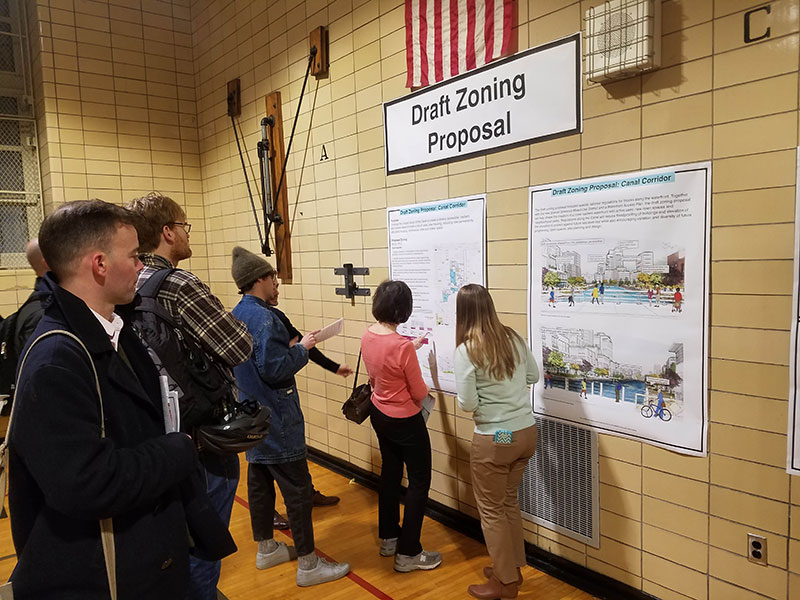
On December 4, 2018, Council Member Lander, NYC HPD, and NYC DCP held a meaningful community conversation about fair housing, race, place, equity, and Gowanus.
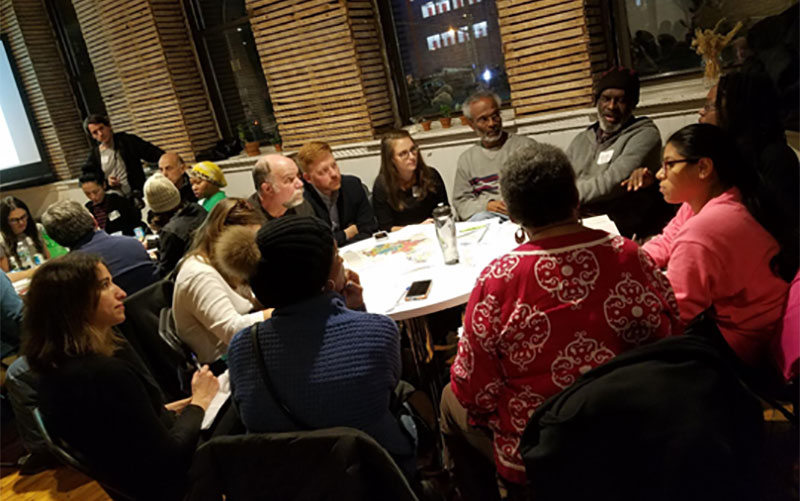
Thank you to those who were able to join the Public Place Community Workshop on November 1, 2018 at P.S. 32. The workshop allowed community members to engage in meaningful dialogue with representatives from DCP, HPD, DPR, and representatives from the designated development team about their goals for the six-acre City-owned site Public Place (also known as Gowanus Green). The workshop involved a series of activities including a visioning and goals exercise where participants were invited to think about their ideal future for Public Place. Participants provided feedback on an updated site plan through discussion and two interactive massing and open space workshop exercises. Using a variety of tools, including wooden blocks representing building massing and images of existing open spaces, each group developed visions for Public Place, taking into consideration the overall community and citywide goals and potential tradeoffs.
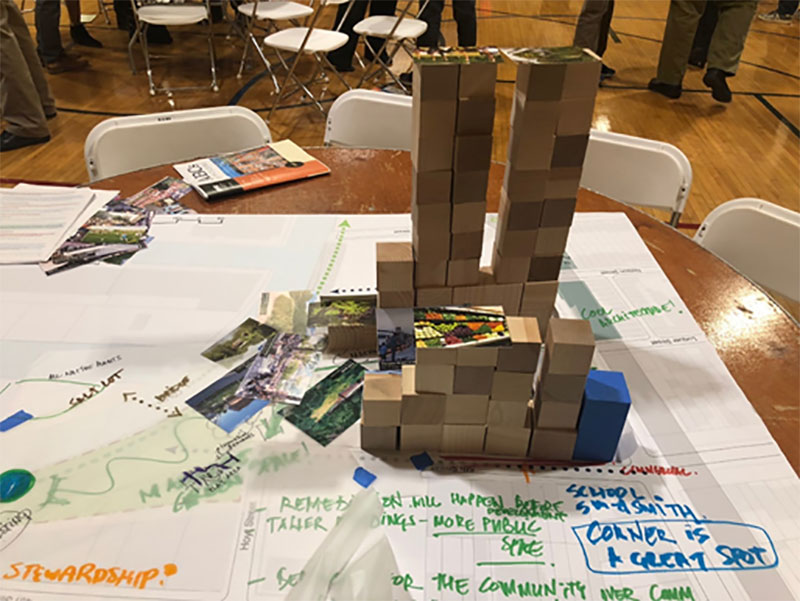
June 27 Open House
Over 200 community members and stakeholders visited the Gowanus Study’s Framework Open House on June 27, 2018 at P.S. 32, where they discussed the recently released study framework with DCP and partner agencies as well as Gowanus residents, workers, and others. At the open house, attendees visited stations focused on each of the framework’s chapters: Sustainability & Resiliency, Environmental Remediation, Community & Cultural Resources, Housing, Economic & Job Development, Transportation, and Land Use & Urban Form. Many provided comments and ideas that will help us take the framework goals and strategies toward implementation as part of a Neighborhood Plan.
The event’s format and goals are described in the ![]() welcome hand-out. Electronic copies of the boards shared at each station are available here:
welcome hand-out. Electronic copies of the boards shared at each station are available here:
 Welcome and Study Information
Welcome and Study Information Sustainability and Resiliency
Sustainability and Resiliency Environmental Remediation
Environmental Remediation Housing
Housing Land Use and Urban Form
Land Use and Urban Form Economic and Job Development
Economic and Job Development Transportation
Transportation  Community and Cultural Resources
Community and Cultural Resources
The feedback and ideas generated at the Framework Open House are provided in the ![]() meeting recap.
meeting recap.
June 11 Community Board 6 Meeting
After Gowanus: A Framework for a Sustainable, Inclusive, Mixed-use Neighborhood was released in early June, DCP provided Brooklyn Community Board 6’s Executive Committee and others with an overview of the framework and an opportunity for discussion at a public meeting on June 11, 2018 at P.S. 32. An ![]() overview hand-out provided that evening include a brief background on the framework, an overview of its structure and organization, and a summary of its key strategies. The
overview hand-out provided that evening include a brief background on the framework, an overview of its structure and organization, and a summary of its key strategies. The ![]() presentation slides provide more information about neighborhood outreach that contributed to the framework, the framework’s key topics and priority goals and strategies, and next steps in pubic engagement and neighborhood planning.
presentation slides provide more information about neighborhood outreach that contributed to the framework, the framework’s key topics and priority goals and strategies, and next steps in pubic engagement and neighborhood planning.
PlanGowanus.com Online Engagement
PlanGowanus.com is an online community engagement platform where you can view the planning framework, give your feedback, and see what others are saying. We encourage you to visit and to share your ideas on how to improve and implement the framework’s goals and strategies, and how to make Gowanus more of an inclusive, mixed-use neighborhood.
Gowanus: A Framework for a Sustainable, Inclusive, Mixed-use Neighborhood, published in June 2018, is a roadmap for potential goals and strategies, including recommended land use changes, to be developed and implemented as part of a Neighborhood Plan. The framework is the culmination of more than 100 hours of public outreach and community meetings to solicit input since the Gowanus PLACES Study launched in October 2016. It is informed by previous reports and studies, including Bridging Gowanus, and ongoing community efforts by government agencies and community stakeholders and organizations.
The vision laid out in this framework aims to foster a thriving, inclusive and more resilient Gowanus where existing and future residents and workers are able to participate in civic, cultural and economic activities and where a wholly unique resource – the Gowanus Canal – can thrive and play an active role in that equitable and sustainable growth.
Framework Overview
This framework document is organized first into chapters that describe planning and policy strategies proposed across the Gowanus neighborhood – addressing Sustainability and Resiliency, Environmental Remediation, Community and Cultural Resources, Housing, Economic and Job Development, and Transportation – followed by a discussion of Land Use and Urban Form.
Gowanus is a neighborhood with a diverse and complex mix of uses. The Land Use and Urban Form chapter identifies three types of areas in Gowanus with distinct approaches and recommendations: Industrial and Commercial, Enhanced Mixed-Use, and the Canal Corridor. To learn what kinds of land use and urban form strategies are proposed in each of Gowanus's different neighborhood sub-areas, see the Land Use and Urban Form framework chapter (above), and explore the Interactive Land Use and Urban Form story map.
INTERACTIVE LAND USE & URBAN FORM FRAMEWORK MAP.
Key Strategies
The framework consists of proposed goals and strategies to make Gowanus a cleaner, greener, inclusive neighborhood that can serve as a model of sustainability for New York City and beyond. Stitched together, the tapestry of policies and proposals aim to support the evolution of Gowanus into an eco-neighborhood where existing and future residents and workers can live, work and play with a minimal carbon footprint and impacts on climate change. Key strategies include:
- Promoting a more resilient future, where buildings and infrastructure are designed to manage flood risk today and into the future
- Increasing public open space that is green and resilient along the Canal and capitalizing on opportunities to green public spaces throughout the area
- Creating new job-generating space and fostering a mix of uses within the neighborhood so residents can live, work, create, play and shop and all users can reach their destinations by walking and bicycling or other means
- Promoting new housing -- creating and preserving affordable housing and improving public housing -- near public transit to further reduce carbon footprint
- Improving access to new jobs, training opportunities and other resources that support social, economic and environmental resiliency in the community
- Improving mobility and safety for pedestrians, cyclists and drivers on streets and public areas
- Planning for meeting the infrastructure and community resources needs of growing neighborhood
Process
Since the neighborhood study launched in October 2016, thousands of community stakeholders, residents, workers, business owners and elected officials have articulated Gowanus's challenges and needs, set goals and objectives, and generated ideas about policies and investments to achieve a thriving, more resilient neighborhood. This framework is a product of all those voices and ideas heard through over 100 hours of meetings and large public events, and DCP's first-ever online engagement forum, PlanGowanus.com.
- 100+ hours of workshops and meetings
- 26 working group meetings
- Four large public events
- NYCHA Tenant Association meetings
- 10,000 visits to PlanGowanus.com
- 30-35 average daily visitors
- 73 contributors placing 220 pins on the comments map
Through refinement and community feedback on this framework, a draft Neighborhood Plan will be developed to begin implementing this collective vision. Evolving from the goals and objectives outlined here, the draft Neighborhood Plan will further align community and government resources with draft zoning and land use changes to realize the shared vision. Land use actions, including rezoning, aimed at facilitating the Neighborhood Plan would subsequently enter public review. For more information, see the timeline and process map below.
Thank you to those who were able to join the Gowanus Study’s Community Resources Meeting: Schools, Transportation, and More on October 19, 2017 at M.S. 51. The event was an open house where participants were able to speak with representatives of DCP, Department of Transportation, Department of Education, School Construction Authority, Department of Environmental Protection, and Human Resources Administration’s Tenant Support Unit, about the Gowanus Study and planning for transportation, public schools, infrastructure and other local needs. The event’s format and goals are described in the ![]() welcome hand-out. Electronic copies of the boards shared by each agency are available here:
welcome hand-out. Electronic copies of the boards shared by each agency are available here:
 Gowanus Study Information & Updates
Gowanus Study Information & Updates Working Group Recommendations
Working Group Recommendations Schools & Education
Schools & Education Streets & Transportation
Streets & Transportation
The feedback and ideas provided, including key planning principles discussed for schools and transportation, are provided in the ![]() meeting recap.
meeting recap.
During the winter and spring of 2017, Working Groups comprised of residents, businesses, elected officials’ representatives, community stakeholders and City agencies met to address topics around Arts & Culture, Housing, Industry & Economic Development, Public Realm, and Sustainability & Resiliency in Gowanus. The Working Groups, which met over 25 times and 80+ hours, were informed by a new online platform Plangowanus.com where data briefs and presentations were posted and shared. The site also posed questions through interactive mapping activities to the broader Gowanus community.
Working Groups: Process
Each working group produced draft recommendations to help shape a forthcoming draft planning and land use framework. Recommendations ranged in specificity from broad goals, objectives and priorities to specific mechanisms and tools (view ![]() study process and outreach approach).
study process and outreach approach).
Working Group Summit
On July 11, 2017, a Working Group Summit was held where members of all Working Groups shared, discussed and prioritized each groups’ draft recommendations. At the Summit, DCP shared a ![]() progress update of the Working Groups and other Gowanus Study outreach to date. In small group discussions, attendees evaluated synergies and potential conflicts among the diverse interests present in Gowanus.
progress update of the Working Groups and other Gowanus Study outreach to date. In small group discussions, attendees evaluated synergies and potential conflicts among the diverse interests present in Gowanus.
- July 11th summit - working group’s comment
 summaries and recommendations.
summaries and recommendations.
Working Groups: Draft Recommendations
The Working Groups’ discussion at the Summit covered the three types of recommendations:
- recommendations that were mutually supported by Working Group members and City agencies (view
 the list);
the list); - recommendations that were generally supported but require additional information and/or research (view
 the list); and
the list); and - recommendations that, although the underlying goals were supported broadly, their implementation mechanisms were beyond the scope or ability of this neighborhood planning study for feasibility, legal or policy purposes and/or were not mutually supported by the Working Group members (view
 the list).
the list).
Along with input from Plangowanus.com, large public meetings and other outreach, these recommendations will help in the development of a draft planning and land use framework and neighborhood plan by giving specific, topic-by-topic voice to items to be balanced and addressed. Discussions will continue on how to best achieve the overall vision for Gowanus and reconcile, where possible, conflicting or competing issues.
Click on each link below to see sketches and visualizations of the Working Group recommendations!
Thank you to all who came out and participated at our workshop on March 25, 2017! Over 100 attendees shared their ideas on locations of uses, activities and improvements related to industry and jobs, housing, public realm, sustainability, resiliency, arts and culture and more. Each table sought to balance the various neighborhood goals in two activities that delved into use compatibility, mixed-use constraints, neighborhood assets and needs and key urban design challenges.
Feedback and results from each table’s activities are documented in the ![]() workshop summary. The results of the workshop will help inform the Study's ongoing community engagement in future public events, smaller forums and working groups, and targeted stakeholder meetings.
workshop summary. The results of the workshop will help inform the Study's ongoing community engagement in future public events, smaller forums and working groups, and targeted stakeholder meetings.
Community Engagement Platform
We are also excited to announce a new way to interact and provide feedback on the neighborhood study. The Department of City Planning is piloting an online engagement platform called Plan Gowanus where you can give your input on a variety of topics in new interactive ways. Plan Gowanus is part of the multi-pronged outreach approach developed in response to feedback from the community.
Welcome to the Gowanus Resiliency & Sustainability Virtual Open House
On December 8, 2016, the Gowanus Neighborhood Planning Study hosted a public meeting on Resiliency and Sustainability. The purpose of the event was to share information about resiliency and sustainability topics in Gowanus and across the city, give the public an opportunity to meet with a cross-section of government agencies and local groups working on these issues in the community, discuss the upcoming public engagement process, and provide a brief summary of the previous month’s kick-off event. A summary of the event and the feedback provided is available in the ![]() meeting recap.
meeting recap.
The handouts, presentation slides, and posters that were available at that meeting are provided below:
Handouts
Attendees received a one-page ![]() Welcome sheet describing the meeting’s format and goals and forms to provide questions (in
Welcome sheet describing the meeting’s format and goals and forms to provide questions (in ![]() English or
English or ![]() Spanish) and priorities, thoughts, and comments (in
Spanish) and priorities, thoughts, and comments (in ![]() English or
English or ![]() Spanish).
Spanish).
Information briefs about flood risk, resilient construction, and flood insurance (in ![]() English or
English or ![]() Spanish) were also available at the event.
Spanish) were also available at the event.
Presentation
Representatives from the Department of City Planning, NYC Office of Environmental Remediation, and Mayor’s Office of Recovery and Resiliency presented on this study’s process and their office’s key work in and around Gowanus (view the ![]() presentation). Specifically, the presentation included information on the City’s recent initiatives in sustainability, environmental remediation, and resiliency; a recap of the October 27 Kick-off event; a description of the study process and proposed working groups.
presentation). Specifically, the presentation included information on the City’s recent initiatives in sustainability, environmental remediation, and resiliency; a recap of the October 27 Kick-off event; a description of the study process and proposed working groups.
Poster boards displayed at the event provided more information and an opportunity for attendees to discuss specific topics and issues with agency staff in an open house format. These boards are summarized and provided below.
Introduction Boards
What is the Gowanus Neighborhood Planning Study? What happened at the Kick-off open house event on October 27, 2016? What are the City’s goals for resiliency and sustainability and what are local residents and community organizations doing to address them now? This set of posters answers those questions and others, and notes the agencies and organizations that partnered with City Planning for the event. View the ![]() Introduction Boards.
Introduction Boards.
Sustainability Boards
What does sustainability mean? What is the City doing to support sustainability in Gowanus? These boards highlight some of the ongoing work of agencies like the Department of Environmental Protection and Office of Environmental Remediation, including green infrastructure installations, sewer upgrades, and brownfield clean-ups. View the ![]() Sustainability Boards.
Sustainability Boards.
Resiliency Boards
What is a “resilient city”? What are the current and future risks of flooding? How are buildings in the floodplain regulated? This set of boards explains some of the City’s current initiatives to reduce flood risk in the face of climate change, including a zoning text amendment for resilient building retrofitting and development, New York City Housing Authority property improvements at Gowanus Houses, and flood-proofing of critical infrastructure. They also provide a list of resources for residents to understand their own flood risk and how to prepare for emergencies. View the ![]() Resiliency Boards, Part 1 and
Resiliency Boards, Part 1 and ![]() Resiliency Boards, Part 2.
Resiliency Boards, Part 2.
Land Use and Zoning Boards
The Gowanus area includes homes, stores, schools and local services, art and entertainment-related uses, auto-oriented businesses, manufacturing, hotels, and other land uses. These boards provide a map of land uses in and around the study area, along with a description and map of local zoning. They provide a brief overview of what zoning is and how it regulates the construction of new buildings and changes to existing buildings. View the ![]() Land Use Boards.
Land Use Boards.
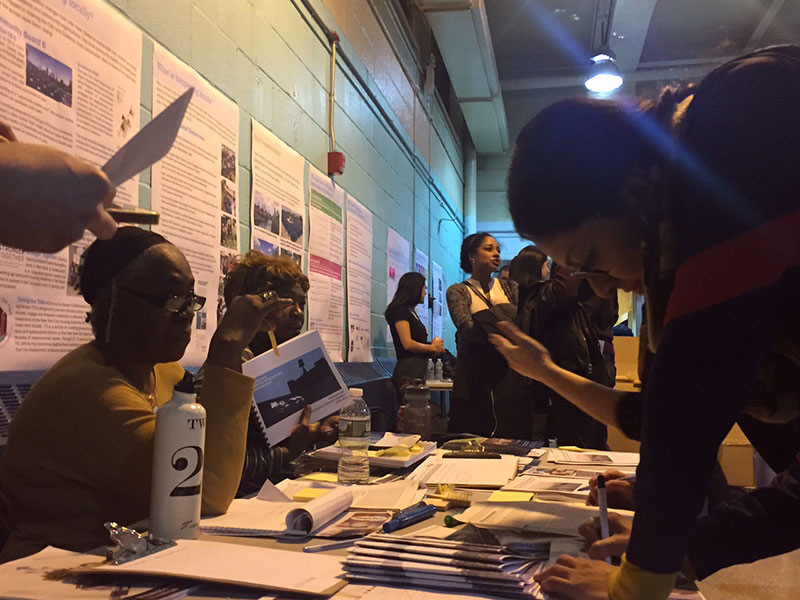
On October 27, 2016, the Department of City Planning hosted a kickoff meeting for the Gowanus Neighborhood Planning Study process. The event began with an open house where local business owners, workers, residents and property owners met with city-agencies around relevant topic areas and discussed the study’s process, approach and goals for the ![]() framework study areas. DCP also gave a
framework study areas. DCP also gave a ![]() presentation that shared the study’s process, approach and broad-based goals.
presentation that shared the study’s process, approach and broad-based goals.
View the “one-pager” handout on the study’s process, approach and goals (![]() English or
English or ![]() Spanish) and our feedback form (
Spanish) and our feedback form (![]() English or
English or ![]() Spanish) that was given out at the meeting. As a follow-up to the event, view the
Spanish) that was given out at the meeting. As a follow-up to the event, view the ![]() meeting recap with a summary of feedback provided at station areas. Please share with us your priorities and goals you would like to see and feel free to reach out for any questions or suggestions by email: gowanus@planning.nyc.gov or by telephone: 718-780-8280.
meeting recap with a summary of feedback provided at station areas. Please share with us your priorities and goals you would like to see and feel free to reach out for any questions or suggestions by email: gowanus@planning.nyc.gov or by telephone: 718-780-8280.
Below are each of the boards from the open house:
Neighborhood Study Background, Goals and Approach
What is the Gowanus Neighborhood Planning Study? What are the goals and approach of the PLACES study process? What are the major milestones?
View the boards for ![]() Study Background and the
Study Background and the ![]() Process and Approach.
Process and Approach.
Sustainability and Resiliency
How do the topics of sustainability and resiliency relate to the Gowanus study? What is the citywide initiative OneNYC? What are some of the key priorities and initiatives for environmental remediation?
View the boards for ![]() OneNYC,
OneNYC, ![]() Sustainability,
Sustainability, ![]() Resiliency, and
Resiliency, and ![]() Environmental Remediation.
Environmental Remediation.
Zoning and Land Use
What is zoning and what does it do? What are waterfront zoning rules? What land uses are located in and around Gowanus?
View the boards for ![]() Zoning Basics,
Zoning Basics, ![]() Local Zoning in Gowanus,
Local Zoning in Gowanus, ![]() Existing Land Uses, and
Existing Land Uses, and ![]() Waterfront Zoning.
Waterfront Zoning.
Housing, Jobs and Economic Development
What role do city agencies play in creating and preserving affordable housing? How does job growth and assisting businesses relate to the study?
View the boards for ![]() Housing and
Housing and ![]() Jobs and Economic Development.
Jobs and Economic Development.
Community Resources
What park or open space do you use? How can we improve streets to make them safer? How do we work towards addressing school needs and assist the arts community in Gowanus? Parks, schools, transportation and arts and culture play a crucial role in the everyday lives of area residents.
View the boards for ![]() Parks and Open Space,
Parks and Open Space, ![]() Schools, Arts and Culture, and
Schools, Arts and Culture, and ![]() Transportation.
Transportation.
Where do you live, work and play in Gowanus?
During the event, we heard from residents, workers and other community members about where they live, work and play.
View the ![]() map board.
map board.
